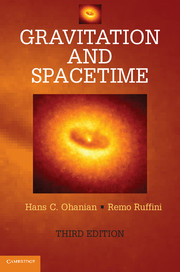Book contents
- Frontmatter
- Contents
- Preface
- Constants
- Notation
- 1 Newton's gravitational theory
- 2 The formalism of special relativity
- 3 The linear approximation
- 4 Applications of the linear approximation
- 5 Gravitational waves
- 6 Riemannian geometry
- 7 Einstein's gravitational theory
- 8 Black holes and gravitational collapse
- 9 Cosmology
- 10 The early universe
- Appendix Variational principle and energy-momentum tensor
- Answers to even-numbered problems
- Index
Preface
Published online by Cambridge University Press: 05 April 2013
- Frontmatter
- Contents
- Preface
- Constants
- Notation
- 1 Newton's gravitational theory
- 2 The formalism of special relativity
- 3 The linear approximation
- 4 Applications of the linear approximation
- 5 Gravitational waves
- 6 Riemannian geometry
- 7 Einstein's gravitational theory
- 8 Black holes and gravitational collapse
- 9 Cosmology
- 10 The early universe
- Appendix Variational principle and energy-momentum tensor
- Answers to even-numbered problems
- Index
Summary
Einstein discovered his theory of gravitation in 1916. By rights, this theory should not have been discovered until 20 years later, when physicists had acquired a clear understanding of relativistic field theory and of gauge invariance. Einstein's profound and premature insights into the nature of gravitation had more to do with intuition than with logic. In contrast to the admirably clear and precise operational foundations on which he based his theory of special relativity, the foundations on which he based general relativity were vague and obscure. As has been emphasized by Synge and by Fock, even the very name of the theory indicates a misconception: There is no such thing as a relativity more general than special relativity. But whatever murky roads he may have taken, in the end Einstein's intuition led him to create a theory of dazzling beauty. If, using Arthur Koestler's image, we regard Copernicus, Kepler, and Newton as sleepwalkers who knew where they wanted to go and managed to get there without quite knowing how, then Einstein was the greatest sleepwalker of them all.
The aim of this book is to develop gravitational theory in the simplest and most straightforward way – in the way it probably would have developed without Einstein's intervention. This means that we begin with the linear approximation and regard gravitation as the theory of a second-rank tensor field in a flat spacetime background, analogous to electrodynamics. The geometrical interpretation and the nonlinear Einstein equations gradually emerge from this tensor theory as we attempt to understand and improve the equations of the linear approximation. This approach is not new: Gupta, Feynman, Thirring, and Weinberg have presented it from somewhat different points of view and with varying amounts of detail. One advantage of this approach is that it gives a clearer understanding of how and why gravitation is geometry.
- Type
- Chapter
- Information
- Gravitation and Spacetime , pp. ix - xiiPublisher: Cambridge University PressPrint publication year: 2013

